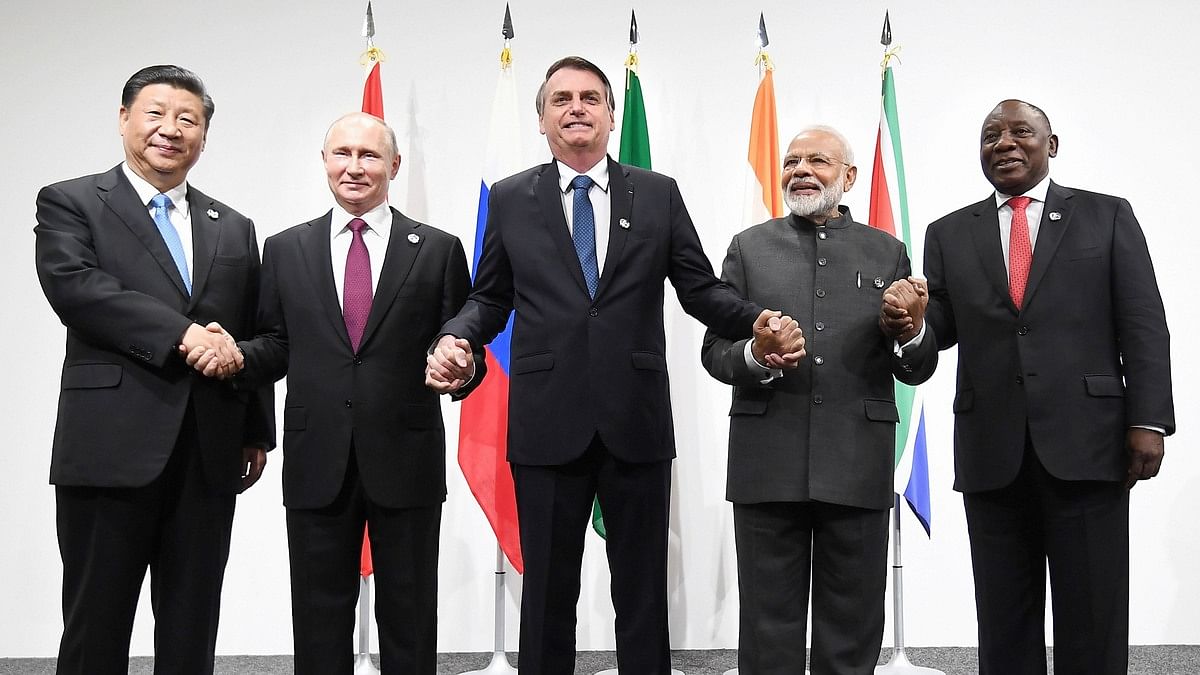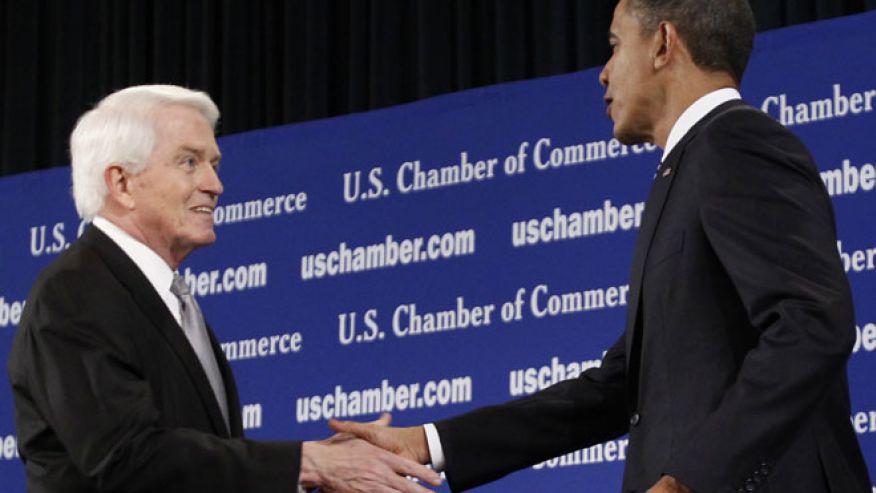The BRICS alliance is a strategic geopolitical partnership between Brazil, Russia, India, China and South Africa. The nature of the alliance is based on trade and big picture economics.
Readers familiar with our discussions of trade and international finance, will remember the importance we previously discussed with BRICS after the 2016 election and President Trump representing economic nationalism for the first time in several generations. In this outline, we are going to share the bigger picture of why BRICS should now be back on the center stage of American focus.

Xi Jinping (China), Vladimir Putin (Russia), Jair Bolsonaro (Brazil), Narendra Modi (India) and Cyril Ramaphosa (South Africa), the BRICS group.
The BRICS economic partnership was formed during the Obama administration. Brazil, Russia, India, China and South Africa (BRICS) saw President Obama sub-contracting, actually giving away, U.S. trade policy to the U.S. Chamber of Commerce. In the aftermath of the 2007 economic crisis created by the financial system, the BRICS group connected two central points that concerned them.
In the aftermath of the great housing/financial crisis, the relationships around the World Bank (WB), International Monetary Fund (IMF), EU central banking system and various multinational institutions and, more importantly, multinational corporations, merged even closer with the government. The priorities of the Davos and World Economic Forum (WEF) crowd were now virtually indistinguishable from many national governments.
We are fifteen years downstream from that inflection point, and we are now seeing the outcomes. The WEF is now giving direct instructions to installed politicians for government policy. Put another way, multinational corporations are now telling government officials what to do.
Think of “The Great Reset” or “Build Back Better” or climate change, as examples. Worse yet, those governments are doing exactly what the WEF has told them to do.
This corporate control of government is exactly what the BRICS assembly foresaw when they first assembled. When multinational corporations run the policy of western government, there is going to be a problem. In the bigger picture, the BRICS assembly are essentially leaders who do not want corporations and multinational banks running their government.
As a result, if you really boil it down to the common denominator what you find is the BRICS group are the opposing element to the WEF assembly.
BRICS are not against capitalism in its original form; the BRICS assembly is against corporatism controlling the outcome of government policy. The leaders of Brazil, Russia, India, China and South Africa joined together in order to make sure their subset of economic power put government at the top of the control and power dynamic, and multinational corporations under them. This is their essential commonality.
President Obama and the people around him from Hyde Park were/are domestically focused ideologues. Much has been written about them, and we will not repeat. However, the lesser emphasized point of the Obama era is how issues that touched on foreign policy were subcontracted to others.
Foreign policy was not a central focus for the Chicago team. They were laser focused on fundamental change inside the United States. Their aspirations were to reduce the geopolitical status of the U.S. on the world stage in the same view as an anti-colonialist would seek to break up the British colonial power structures. This is an important reference point often missed.
Hillary Clinton could essentially manage the State Dept as she wanted as long as the overarching intent of the Obama policy was maintained. Spreading the wealth, diminishing the U.S. role of influence, and raising up the rest of the world was the only objective of Obama foreign policy.

Obama took that same outlook toward U.S. strategic trade interests. This is why President Obama subcontracted trade policy to the President of the U.S. Chamber of Commerce, Tom Donohue (pictured above).
During President Obama’s terms in office, the U.S. CoC, the lobbying entity of Wall Street favor, literally was in charge of trade policy. The U.S. CoC wrote the language, the actual terms and conditions of U.S. government trade policy.
At the time when the U.S. CoC was tasked and permitted to do this, the Transpacific Partnership (TPP) trade deal was being written. The U.S. Chamber of Commerce was literally writing the language in the TPP and negotiating with the other nations involved. Put another way, the operational arm of the multinational Wall Street corporations was writing trade agreements. Can you see how the corporations were positioned?
On the Atlantic side, the Transatlantic Trade and Investment Partnership (TTIP) was also coming next once TPP was finished. It was not the U.S. government negotiating these terms, it was Wall Street and the Multinational Corporate and Financial establishment, via the Chamber of Commerce, writing these deals. See the problem?
The leaders within BRICS could see the future of what this process would mean. Everything is about the economics. There are trillions at stake.
Additionally, the Word Economic Forum, the assembly of the multinational corporations in control of economics and trade, would now be dictating policy to NATO, the European Union, Central Banks, International Monetary Fund, World Bank and eventually the World Trade Organization (WTO).
BRICS could see that corporations would be in control of western government finance and trade, and as a consequence, when those same multinationals approached them for trade negotiations, the size of influence of the corporations would be, could be, too massive to fight. BRICS assembled in 2009 to unite, defend and combat this problem. This was their core mission, their commonality.
When President Trump was elected, for the first time since their assembly, BRICS saw a U.S. President with a completely different agenda. Donald Trump was not in favor of multinational corporations running and influencing government. Ideologically, as an economic nationalist, Trump was of the same mindset as the BRICS group. WATCH (1 minute):
When President Trump took office, he literally tore up the TPP trade agreement that Tom Donohue had established, he kicked the U.S. Chamber of Commerce out of government, and he established his own trade negotiating teams to put government back in charge of trade policy.
President Trump took us out of TPP, withdrew from the Paris Climate Treaty, dropped TTIP, triggered NAFTA renegotiations, initiated tariffs against our economic adversaries (multinationals) and told NATO to start preparing to take care of themselves. Trump was the first economic nationalist president in modern history.
Commerce Secretary Wilbur Ross, U.S. Trade Representative Robert Lighthizer, Treasury Secretary Steven Mnuchin and White House Trade and Economic Advisor Peter Navarro took over from the U.S. Chamber of Commerce. Trump established the economic and trade goals, the team worked the granular details, and ultimately Trump made the decisions, yes or no.
After Trump took this approach, the BRICS group essentially dissolved.
With the United States now confronting the WEF, NATO, the EU and all the multinationals (often called globalists), the BRICS team could pause their mission.
Factually, BRICS didn’t even meet during Trump’s term, because the U.S. trade and economic policy known as ‘America First‘, was essentially in alignment with the BRICS mission.
Unfortunately, it was the scale of the WEF, EU, NATO and multinational opposition to President Trump that eventually won. All the multinational corporations, including Big Tech and ideological globalists in media, aligned to remove President Trump. That was the scale of the opposition.
In the aftermath of the 2020 election, literally just days after the election, the BRICS group was back on the phone planning to start meetings again in 2021 on the sidelines of the G20 summit. The BRICS group are back together because the multinationals are back in control.
For obvious reasons, part of the BRICS agenda is to create a trade currency that is not the dollar. With the recent sanctions put into place against Russia, we can see why that was always going to be important.
In many very direct ways, what we are seeing in this Russia -vs- Ukraine crisis is a geopolitical battle between the outlook of BRICS (economic nationalists) and the NATO, EU, World Economic Forum, multinational corporate assembly, i.e. economic globalists.
At stake in the Ukraine battle is the modern structure of the global economy and international politics. This is why we see Joe Biden along with NATO, the EU and all of the affiliates under the control of the World Economic Forum going so hard against Russia.
EXAMPLE: India would not denounce Russia during the United Nations Security Council vote. Now Biden retaliates.
- The Biden administration is looking whether to apply or waive sanctions on India for its purchase of the S-400 Triumf missile defense system from Russia, under Countering America’s Adversaries Through Sanctions Act (CAATSA)
- Lu’s remarks came as India drew criticism from US lawmakers, both Republicans and Democrats, at a hearing on the “US relationship with India” for being among 35 nations that abstained Wednesday from a UN vote to rebuke Russia’s invasion. (LINK)
We already know which side corporate media, Big Tech, Hollywood and the social media control officer’s support.
Will the multinational corporations win, or will Russia with the ideological support of China, India, South Africa and Brazil be victorious?
If the World Economic Forum beats Russia, that tells me all I need to know.
…I’ll be joining the Amish.
[Support My Relocation HERE]

Thank you again Sundance. You explain everything. People need to be educated about what’s happening instead of a social media war campaign about who’s cool and who’s not.
“oh look he’s been on dancing with the stars “!!!
not sure i agree that BRICS is a unified alliance.
Aren’t China and India waging war at their common border with China trying to take away India’s land?
I heard that India didn’t vote against Russia at the UN and I didn’t not understand why. Now I do. I had forgotten about BRICS. Thanx for the refresher course.
BRICS hold an annual summit and did so during the Trump yrs. In fact, the 2018 Summit generated this headline
“BRICS nations pledge unity as trade war threatens”
https://news.yahoo.com/brics-nations-pledge-unity-trade-war-threatens-155009817.html
So, not sure what Sundance is means by “Factually, BRICS didn’t even meet during Trump’s term, because the U.S. trade and economic policy known as ‘America First‘, was essentially in alignment with the BRICS mission.”????
The fault lies with NATO that couldn’t be content having won the Cold war. They had to push and push, continue humiliating Russia, till they had closed the noose around Russia, then lord and crow over the defeated. Even our politicians don’t realise what a dangerous position the world is in. One false move or misinterpreted act, can lead to a West in an ash heap.
Great article making the connection of the creation of the BRICS to Ukraine, now! It’s just like the connection of the Nord Stream-2 with the addition of Germany which the US doesn’t want to ever happen!
The outcome will decide if we continue to be a free sovereign world or a One World Government of Tyrannical, Totalarian Control.